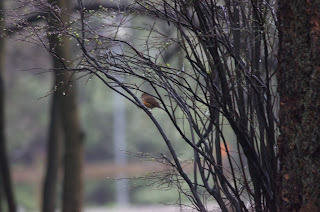Regular followers of this blog may remember that my nemesis
bird in Alberta was the Pileated Woodpecker. I finally tracked one down early last year and
finally had some decent views in the fall. This
year seems to be off to a different start on the woodpecker front!
To begin with, a
Pileated Woodpecker was the very first bird I
saw for the entire year. Arriving
at dawn in the Shannon Terrace parking lot of Fish Creek Provincial Park for
our January 1st bird count, one of these crow-sized woodpeckers flew
across the valley calling as it went.
There have been more sightings since then, notably a pair of birds
feeding at ground level by the bike path in Bebo Grove a short distance from
our bird course group.
 |
Above: Pileated Woodpecker, Dryocopus pileatus, Bebo Grove, Fish Creek Provincial Park
Below: Example of flight call from xeno-canto.org |
On that January 1st bird count, even
the Pileated wasn’t the woodpecker highlight of the day, as we found a
Black-backed Woodpecker later in the morning. There had been some sightings earlier in the winter and we
soon found tell-tale signs of the feeding activity of a three-toed woodpecker species. The three species in this group are
specialist woodpeckers, needing mature coniferous forests with dead and dying trees, from which they meticulously peel the bark, searching for insect larvae. The resulting pile of fine bark shavings in the
snow around the base of these trees is distinctive but sometimes finding the responsible bird is a little trickier. Eventually one of our group members
spotted this beauty feeding high up on spruce trunk and we were able to watch
it at work.
 |
| Black-backed Woodpecker, Picoides arcticus, Marshall Springs, Fish Creek Provincial Park |
In the same genus (for now?) as the three-toed woodpeckers
are the Calgary area's more common species – the Hairy Woodpecker and the ubiquitous
Downy Woodpecker - both of which we also saw on that woodpecker-filled New Year's Day. Although common, these two
species can play tricks on birders, as they can be confused with each
other. Here’s the Hairy
Woodpecker, in South Glenmore Park last year.
 |
Hairy Woodpecker, Picoides villosus, South Glenmore Park, Calgary.
The red spot indicates that this is a male bird. |
There are a few physical characteristics that help to separate the two species. The Hairy is larger than the Downy, although there is a tiny
bit of overlap between the smallest and largest of the two species. The outer tail feathers on a Hairy are pure white - although this can be hard to see and is not universally true. Less ambiguously, the bill is always
proportionately larger in the Hairy – as long as the head. However, the easiest way to tell the two species apart is their calls. The Hairy is fairly flat in pitch while the Downy's call is distinctly descending (“Downy goes down”). Here’s
the Downy Woodpecker, this one at Inglewood Bird Sanctuary. If you look closely you can see the black spots on the outer tail feathers and the bill is clearly shorter than the bird above, but it's that call that makes it clear, as you can hear below.
 |
Above: Downy Woodpecker, Picoides pubescens, Inglewood Bird Sanctuary, Calgary.
No red spot on the head means this is a female.
Below: Example of call from xeno-canto.org |
Four of Calgary’s woodpecker species on January 1st is a
pretty good start to any birding year.
I’ve seen Northern Flicker since then which leaves three more common
Southern Alberta woodpeckers – American Three-toed, Red-naped Sapsucker, and
Yellow-bellied Sapsucker – to turn up for the remainder of the year. Here’s to the year of the woodpecker!
.jpg)
.jpg)













